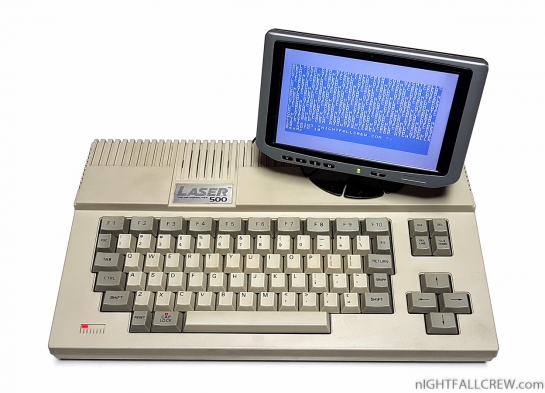
Thanks to my friend Andry for the donation of this computer.
The laser 500 is identical to the previous version, the laser 350. The only differences are in the memory configuration (64 KB instead of 16 KB), the keyboard (77 keys instead of 49) and extended graphics modes.
Technical features:
- Production: 1985
- CPU NEC D780c (Z80A compatible) at 3.7 MHz
- RAM: 64 KB, expandible to 128 KB
- ROM: 32 KB
- Text modes: 40 x 24 in 16 colors and 80 x 24 in 2 colors.
- Graphic modes: 160 x 96 a 16 col., 160 x 192 a 2 col., 320 x 192 a 2 col., 160 x 192 a 16 col., 320 x 192 a 2 col., 640 x 192 a 2 col.
- Sound: 1 voce, 6 octave (Beeper)
- I/O ports: Tape-recorder (600 bauds), Composite Monitor out, RF Port, Memory expansion port.
- Power supply: 9v 500mA (Positive Centre)
Gallery:
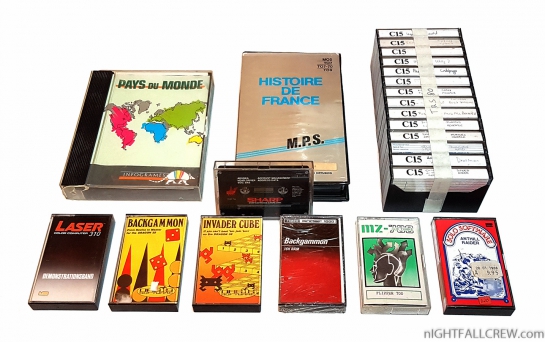
Thanks to my friend Andry for the donation of a few Software on tape.
Thomson MO5/TO7/TO9:
- Histoire de France (M.P.S.)
- Pays du Monde (Infogrames)
Vtech Laser 310:
- DemostrationsBand (Vtech)
Dragon 32:
- Backgammon (Oasis Software)
- Invader Cube (Oasis Software)
Sharp MZ-700:
- Anthill Raider (Solo Software)
- Flipper 700 (Tecnomec)
- Advoka.
- Head Driver.
- Egg Bas.
- Account Management.
- Address Data.
Timex Sinclair 1000:
Radio Shack TRS-80:
- Some tapes of not original software.
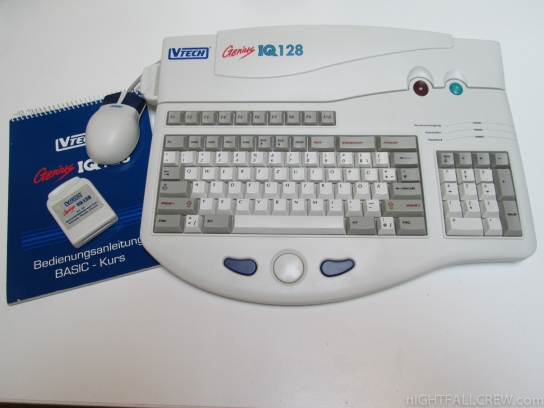
Autopsy:
The Genius PC is a home computer from VTech. Released in the late 90s, it is one of the last microcomputers.
This computer have different names in each country, making it even harder to track down the information.
- France : VTech Genius PC
- Germany : VTech Genius IQ 128 and VTech TV 512
- UK : VTech IT Unlimited
- USA : VTech Precomputer Unlimited
- Also mentioned on the french packaging : Switzerland, the Netherlands, Canada.
Hardware:
- Motorola MC68EC000, 16-bit external databus, 32MHz
- 256K of RAM
- 2M of ROM – Sharp LH537NWN mask ROM
- Mass storage : 128KB flash memory – AM29F010
- Cartridge port, apparently on memory bus with system ROM and storage flash. The french system comes with cartridges only containing straps, likely shorting some pins enable extra features…
Downlod: VTECH Unlimited Manual (1647)
Hardware Video Review:
source: pulkomandy.tk/projects/avrstuff/wiki/geniuspc
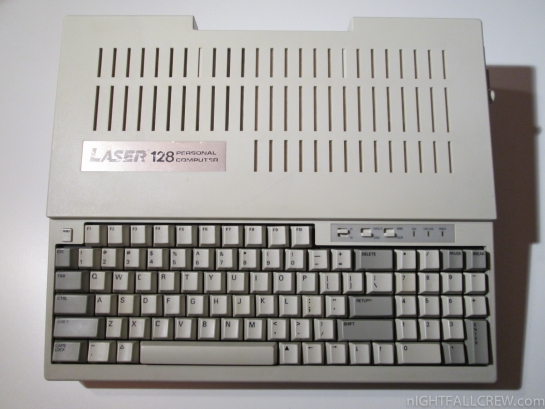
Autopsy:
from Wikipedia homepage:
The Laser 128 was a clone of the Apple II series of personal computers, first released by VTech in 1984. Unlike the Apple II clones from Franklin, VTech reverse-engineered the Apple ROMs using a clean room design rather than copying them. Apple Computer challenged VTech in court, but unlike its efforts directed at Franklin, Apple was unable to force the Laser 128 off the market.
As its name suggests, the Laser 128 had 128 KB of RAM. Like the Apple IIc, it was a one-piece semi-portable design with a carrying handle and a single built-in 5¼-inch floppy disk drive. Unlike the Apple IIc, it had a numeric keypad and a single Apple IIe-compatible expansion slot, which gave it better expansion capabilities than a IIc. VTech offered a metal 2-slot card cage that sat alongside the Laser 128 and attached to the computer’s single slot, allowing for even greater expansion flexibility. The Laser 128 retailed for about $700, substantially less than the price of an Apple IIc.
Apple countered the Laser 128 with its upgraded Apple IIc Plus. VTech responded with the Laser 128EX and the Laser EX2. The Laser 128 was aggressively marketed, both by mail order firms and in retail and catalog stores such as Sears. Even though its ROM was not derived from Apple’s ROM, the Laser 128 series had a high degree of compatibility with its competition from Apple.
VTech owed much of this compatibility to the fact that they were able to license Applesoft BASIC (which constitutes the largest and most complex part of an Apple II’s ROM contents) from Microsoft just as Apple did, heavily reducing the amount of code that had to be reimplemented. Microsoft had made most of its money by keeping the rights to the software that it sold to others. Likewise, Apple had failed to secure an exclusive distribution license for the Applesoft dialect of BASIC, and VTech was free to buy it. Much Apple software depended on various assembly routines that are a part of BASIC in ROM, and it’s quite likely that the Laser would not have been as successful had it not had compatible ROM entry points.
Download:
Game loading:
source: wikipedia
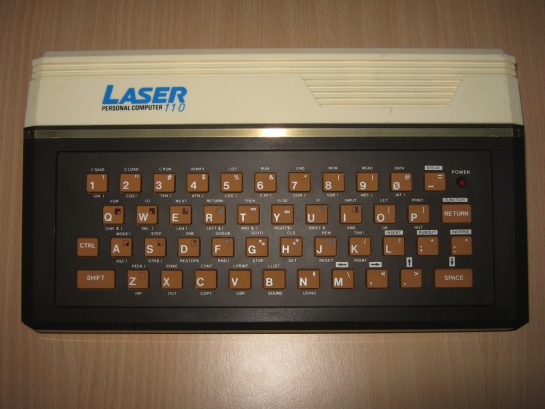
Autopsy:
from old-computers.com homepage:
The Laser 100/110 was the first model of the Laser 100/200/300 family. The ROM was nearly identical to the one of the Tandy Radio-Shack TRS-80 Color Computer, with only minor changes. It’s so close that when people write Laser emulators, they use TRS-80 CoCo ROM documentations (Laser detailed documentations are hard to find, especially about the ROM itslef).
The Basic was a Microsoft Basic just slightly modified to avoid lawsuits, some statements being stored in the ROM but not available on the machine! Like the most of the Vtech products, the Laser 100/110 was “cheaply” conceived: chicklet keyboard, plastic case, light-weight… It was produced to compete against the first wave of micro-computers like the famous Sinclair ZX-81.
The difference between the Laser 100 and the Laser 110 must be the RAM size (like the Laser 200 and 210), though very little information on the Laser 100 is available. The biggest difference with its big brother the Laser 200 was that it only had a black & white display. An obscure VZ-100 version was also released but this wasn’t the same machine as the VZ series sold in Australia and New-Zealand by Dick Smith Electronics.
source: old-computers.com




















































Recent Comments